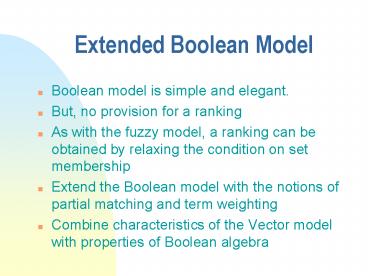Extended Boolean Model - PowerPoint PPT Presentation
1 / 10
Title:
Extended Boolean Model
Description:
(k1 k2) k3. k1 and k2 are to be used as in a vectorial retrieval while the presence of k3 is ... q1 = (k1 k2) k3. q2 = (k1 k3) (k2 k3) sim(q1,dj) sim(q2,dj) ... – PowerPoint PPT presentation
Number of Views:130
Avg rating:3.0/5.0
Title: Extended Boolean Model
1
Extended Boolean Model
- Boolean model is simple and elegant.
- But, no provision for a ranking
- As with the fuzzy model, a ranking can be
obtained by relaxing the condition on set
membership - Extend the Boolean model with the notions of
partial matching and term weighting - Combine characteristics of the Vector model with
properties of Boolean algebra
2
The Idea
- The extended Boolean model (introduced by Salton,
Fox, and Wu, 1983) is based on a critique of a
basic assumption in Boolean algebra - Let,
- q kx ? ky
- wxj fxj idf(x) associated with
kx,dj max(idf(i)) - Further, wxj x and wyj y
3
The Idea
- qand kx ? ky wxj x and wyj y
(1,1)
ky
dj1
AND
y wyj
dj
x wxj
(0,0)
kx
4
The Idea
- qor kx ? ky wxj x and wyj y
(1,1)
ky
dj1
OR
dj
y wyj
x wxj
(0,0)
kx
5
Generalizing the Idea
- We can extend the previous model to consider
Euclidean distances in a t-dimensional space - This can be done using p-norms which extend the
notion of distance to include p-distances, where
1 ? p ? ? is a new parameter - A generalized conjunctive query is given by
- qor k1 k2 . . . kt
- A generalized disjunctive query is given by
- qand k1 k2 . . . kt
6
Generalizing the Idea
p
p
p
- sim(qand,dj) 1 - ((1-x1) (1-x2) . . .
(1-xm) ) m
7
Properties
8
Properties
- By varying p, we can make the model behave as a
vector, as a fuzzy, or as an intermediary model - This is quite powerful and is a good argument in
favor of the extended Boolean model - (k1 k2) k3
- k1 and k2 are to be used as in a vectorial
retrieval while the presence of k3 is required.
9
Properties
- q (k1 k2) k3
- sim(q,dj) ( (1 - ( (1-x1) (1-x2) ) )
x3 ) 2
2
p
p
p
10
Conclusions
- Model is quite powerful
- Properties are interesting and might be useful
- Computation is somewhat complex
- However, distributivity operation does not hold
for ranking computation - q1 (k1 ? k2) ? k3
- q2 (k1 ? k3) ? (k2 ? k3)
- sim(q1,dj) ? sim(q2,dj)































